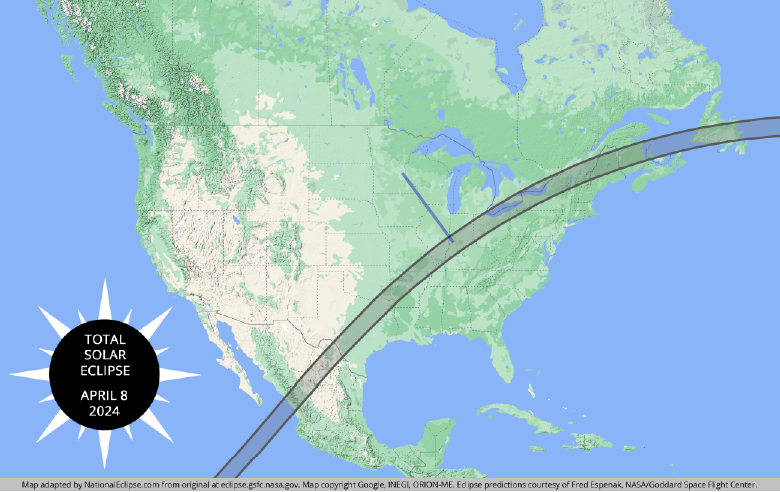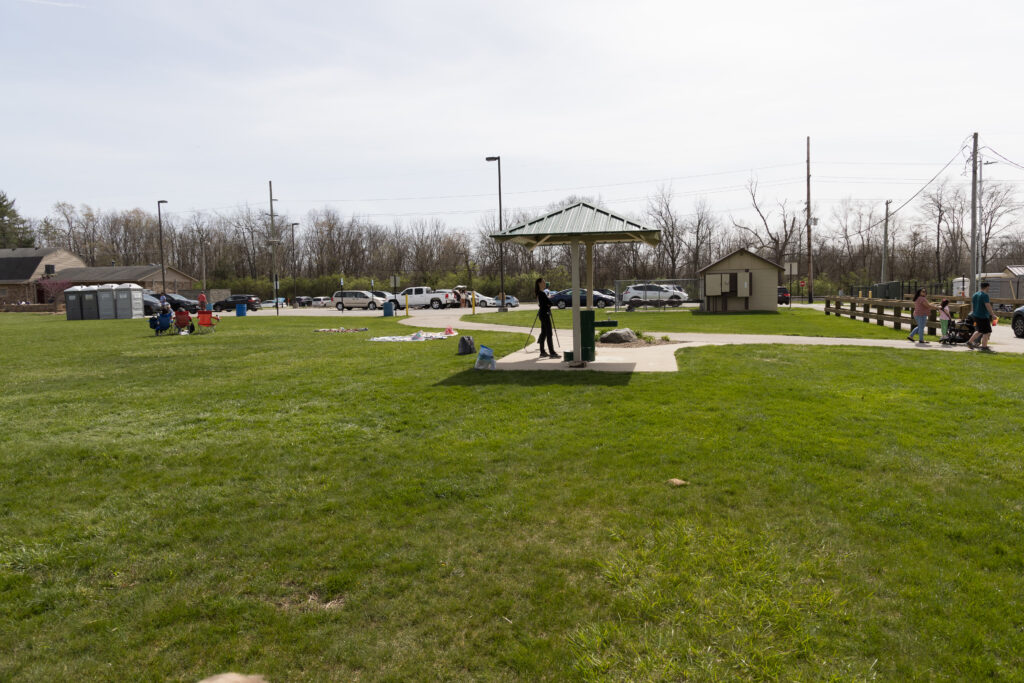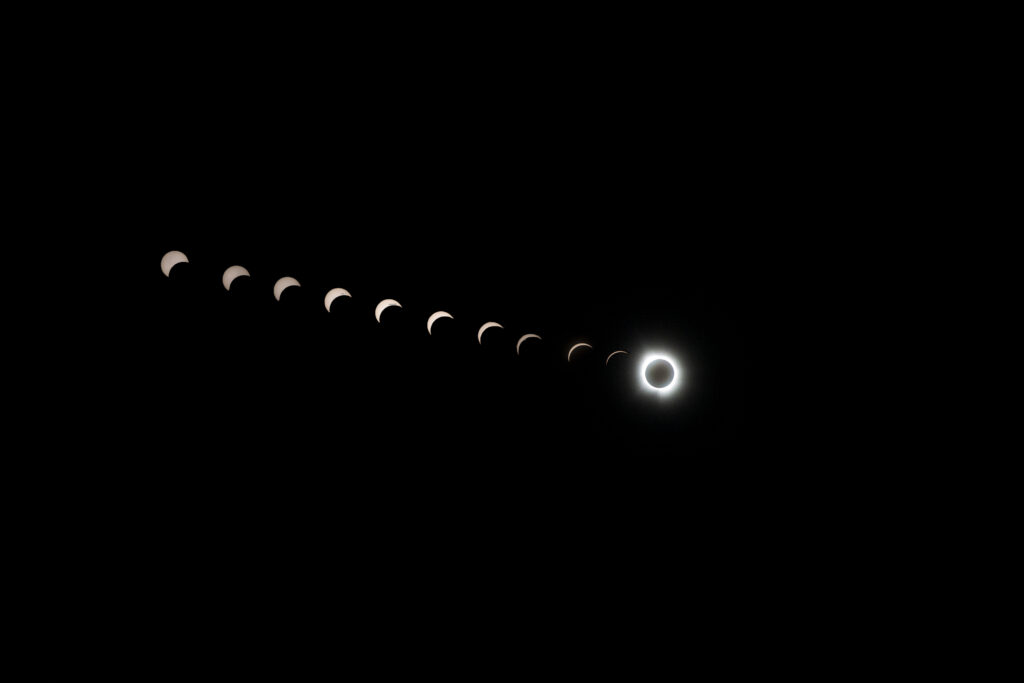On August 21st, 2017, I was standing in the office in downtown Minneapolis, straining to see the partial eclipse through cloudy skies, and only occasionally seeing anything interesting. Disappointed, it was at that time that I vowed that seven years later, no matter what, I’d go see the total eclipse from somewhere when the next eclipse happened in 2024. Finally, nearly seven years later, I fulfilled that quest and saw totality with my family on April 8th just outside of Indianapolis.
In 2017, seeing totality wasn’t top of mind. Sonja was just two years old then, not old enough to be able to remember anything had we attempted to see totality. And Stellan had seven months to go before he was even born. However, when seven years had passed, both children would be old enough to be able to remember the experience, making such a trek worthwhile for everybody. I knew that it was a once in a lifetime opportunity, something that I had wanted to see since I was a kid, but never had the chance.
Growing up, I was very into astronomy. I had astronomy books, a subscription to a kid’s astronomy magazine called Odyssey, and looked through the telescope we got for Christmas one year at the moon and fuzzy stars. I had seen pictures in books of the 1979 eclipse, the last one to be visible from the continental U.S., and wished that I could have seen it myself. While I saw plenty of lunar eclipses in my youth, I don’t remember even a partial solar eclipse during that time. Maybe in 1991 I could have had a glimpse, but honestly I can’t remember.
That changed in 2017, and although the experience from Minnesota was less than amazing, it got me thinking about how to make sure when 2024 rolled around, we’d be able to see totality. Step one was to decide where to go. Some people took into consideration projected cloud cover and other weather, crowd size, and all sorts of variables. Me, I simply reasoned that the shortest line between a point (home) and a line (the path of totality) is a line perpendicular to the first line, drew this map in my head:

That put us somewhere in Indiana, not far from Indianapolis. Indianapolis it was!
Next was to book a place to stay. Since hotels allow booking a year in advance, in April 2023 I started looking for a place to stay. Even then, the choices were few and prices were already incredibly high. I stumbled upon an AirBNB-type service, Vio, and found an apartment to stay in from April 7th to April 9th. That way, we could come in Sunday, have plenty of time to scope out a viewing area on Monday, and leave Tuesday morning, avoiding all of the day-of traffic.
With accommodations booked, there was nothing to do but wait. And wait I did, until this January, I received an email: Vio was going bankrupt, and my reservation was cancelled (in retrospect, Vio seemed to have issues even before bankruptcy). Fortunately, I was able to find less-spacious accommodations in a suburb of Indianapolis, Brownsburg, without too much difficulty. It was in the path of totality, and on the northwest side Indianapolis, making it more convenient for us.
April came closer, time off from work and school was booked, and all of us — me, my lovely wife Julia, Sonja, and Stellan — decided to leave on Saturday and stop in Madison, the rough halfway point, so the kids wouldn’t be stuck in the car too long on the way out there. Finally, a week beforehand, I started paying attention to the weather forecasts. We were driving just in case we needed to drive a few hours out of the way the day of to be clear of clouds, but at least at that point, the cloud cover seemed pretty extensive. Knowing how notoriously inaccurate cloud cover forecasts are a week out, though, I just sat back and waited for change.
As the days marched on, a minor miracle appeared to be taking shape: Indianapolis, despite being the odds-on favorite to have clouds in early April, was shaping up to have a pretty good forecast. Conversely, Texas, which typically has the clearest spring skies, was looking like it would be stormy. Everything was a go.
Stopping in Madison was a great idea, as it meant we didn’t have to leave early on Saturday and just had a four-hour drive in the afternoon. We stayed the night and left for Indianapolis on Sunday. Driving through Chicago had the typical traffic, but then driving down Interstate 65 to Indianapolis was quite backed up. Moreover, there were storms and heavy rain for much of the drive. We finally made it to the hotel and got ready for the next day.
After a trip in the morning to get some supplies like sunscreen and some snacks, and then an extra emergency trip to get sunglasses for the kids because it was “so bright”, we walked to Arbuckle Acres park in Brownsburg (an aside: Sonja is very much into Garfield and because cartoonist Jim Davis is from Indiana, the name of the part prompted a lot of discussion). The park had a playground to keep the kids busy while the moon crept slowly across the solar disk, and that’s what they did while it got steadily darker.

Ten minutes before totality, we called the kids over to sit down and watch the final countdown. The light got dimmer and dimmer and took on a desaturated quality. Streetlights started coming on, and as we watched through the eclipse glasses we had brought, finally the last sliver of sun disappeared. We took off our glasses and saw an amazing sight, one I will never forget: the completely blacked-out sun with the corona visible around, and a red solar flare visible at the bottom of the disk.
I had set up my camera to take a timelapse as the eclipse happened, and this is what I put together. There’s no way I could capture what it truly looked like on my camera, and I didn’t want to spend precious seconds messing around with settings and trying to capture the perfect shot when I just wanted to enjoy the spectacular experience of totality. I do think it looks pretty cool though:

Once totality ended and the light slowly came back, we hung around for a bit, then started walking back to the hotel. By the time we got back, there was the barest chunk of black still visible on the sun when looking through our eclipse glasses: the moon had almost reached Fourth Contact. In another few minutes, it had done so, and the eclipse was officially over.
I’m incredibly glad we were able to see this, and experienced totality, the amazing diamond ring effect when totality ended, and the oddness that is seeing an eclipse like this. Even if it meant 11 hours in a car coming back on Tuesday and the exhaustion of it all. This was an experience that I hope the children remember forever. And the next eclipse visible from a large part of the U.S. is in 2045; it’s a bit early to be planning for that one, but if I’m around, I’ll try to make it.
